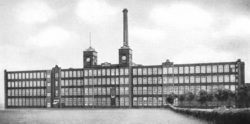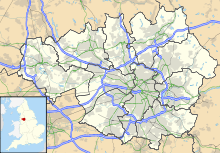- May Mill, Pemberton
-
Coordinates: 53°31′39″N 2°40′11″W / 53.5276°N -2.6698°E
May 
Cotton Spinning (ring mill) Location Pemberton, Wigan Further ownership Lancashire Cotton Corporation (1930s) Courtaulds (1964) Coordinates 53°31′39″N 2°40′11″W / 53.5276°N -2.6698°E Construction Built 1889 Demolished 1980 Equipment Date 1905–1950 Manufacturer Howard & Bullough, Platt Brothers, Geo. Hattersley References [1][2] [1] May No. 1 [[|border|250px]] Construction Completed 1898 Demolished 1980 Power Date 1892 Construction Firm B Goodfellow Engine Type cross compound engine Valve Gear Corliss valves rpm 62rpm Diameter of Flywheel 20ft Type of transmission rope No, of Ropes. 24 Boiler configuration Pressure 180psi May No. 2 [[|border|250px]] Power Date 1901 Construction Firm Ashton Frost Engine Type cross compound engine Valve Gear Corliss valves rpm 62rpm Diameter of Flywheel 28ft Type of transmission ropes No, of Ropes. 34 Boiler configuration Pressure 180psi May Mill, Pemberton is a cotton spinning mill in Pemberton, Wigan, Greater Manchester. It was built in 1889. It was taken over by the Lancashire Cotton Corporation in the 1930s and passed to Courtaulds in 1962–63 to produce carpet fibre, and this it continued to do until its final closure on Friday, 17 October 1980.
Contents
Location
Pemberton is an area of Wigan, and an electoral ward of the wider Metropolitan Borough of Wigan,[3] in Greater Manchester, England.[4] It lies on the southwestern bank of the River Douglas,[5] south west and 2.4 kilometres (1.5 mi) from Wigan's town centre. It is 15 miles (24.1 km) south of Preston, 16.5 miles (26.6 km) west-northwest of Manchester, and 17.4 miles (28 km) east-northeast of Liverpool. Pemberton and Wigan lie in a synclinal basin, where the middle coal measures of the Lancashire Coalfield outcrop allowing open cast workings. There was ready fuel for the steam engines of the mills. In the 1830s Wigan became one of the first towns in Britain to be served by a railway; the line had connections to Preston and the Manchester and Liverpool Railway.[6] It had easy access to the Leeds and Liverpool Canal.
History
Pemberton's history was built on coal and cotton. The first May Mill was built in 1889 on the site of Wilde's Mill, a woollen mill built in 1850 and destroyed by fire on 13 June 1859. A second mill, known as Roper's Mill was built and also burnt down after a fire started in the engine house. In January 1889 the May Mill Spinning Company limited was formed to build a new fireproof mill to replace the one destroyed. The cornerstone was laid on 25 March 1889 and the engines, named Louisa and Helen, were dedicated in May 1890.[1]
The industry peaked in 1912 when it produced 8 billion yards of cloth. The Great War of 1914–18 halted the supply of raw cotton, and the British government encouraged its colonies to build mills to spin and weave cotton. The war over, Lancashire never regained its markets. The independent mills were struggling. The Bank of England set up the Lancashire Cotton Corporation in 1929 to attempt to rationalise and save the industry.[7] May Mill, Pemberton was one of 104 mills bought by the LCC, and one of the 53 mills that survived through to 1950.
Architecture
Power
May No 1 was driven by 800 hp cross compound engine by B Goodfellow, 1892. It had a 20-foot flywheel, 24 ropes operating at 62 rpm. The boilers were 30-foot by 8-foot high-pressure Lancashire boilers. The mill was lit by electricity generated by a Parson's dynamo.
May No 2 was driven by a 1500 hp cross compound engine by Ashton Frost, 1901. This had a 28-foot flywheel, 34 ropes operating at 62 rpm. [8]
Equipment
In 1946 May Mill had 77,964 ring spindles, but by 1948 this had fallen to 72,984. It was re-equipped around 1950. Between 1960 and 1962 the mill was converted to electric ring spinning frames. The mill was eventually taken over by Courtaulds in 1962–63 to produce carpet fibre, and this it continued to do until it finally closed on Friday 17 October 1980.
At the invitation of the assistant manager, Mr. Bill Crank, the Winstanleys, authors of the book cited below, visited May Mill in September 1980. They said:
Although we expected to see some old spinning machines, we were very surprised to find so many still in use; in fact, there was very little new machinery. Many of the machines were pre-1920, and some dated to about the turn of the century. Slubber and drawing frames were said to be part of the original May Mill equipment These were made in 1902 by Howard & Bullough of Accrington. Numerous carding frames by Platt Brothers of Oldham were dated 1905, 1907 and 1920, but some of these had been converted to suit Courtauld's needs. Fly frames, also made by Howard & Bullough, were dated 1915. The scutchers made by Platt Brothers, were built in 1921 and 1924. Cone winders by Geo. Hattersley were made about 1950. Perhaps the most modern machines were ring spinning frames, dated 1967.[1]Usage
Owners
- Lancashire Cotton Corporation (1930s–1964)
- Courtaulds (1964–
See also
Lancashire cotton Architects 
Engine makers Daniel Adamson · Ashton Frost · Ashworth & Parker · Bateman & Sherratt · Boulton & Watt · Browett & Lindley · Buckley & Taylor · Carel · Earnshaw & Holt · Goodfellow · Fairbairn · W & J Galloway & Sons · B Goodfellow · Hick, Hargreaves & Co · Benjamin Hick and Sons · John Musgrave & Sons · J & W McNaught · Petrie of Rochdale · George Saxon · Scott & Hodgson · Urmson & Thompson · Yates of Blackburn · Yates & Thom · Whilans · J & E Wood · Woolstenhulmes & RyeMachinery makers Brooks & Doxey · Butterworth & Dickinson · Curtis, Parr & Walton · Dobson & Barlow · John Hetherington & Sons · Joseph Hibbert · Howard & Bullough · Geo. Hattersley · Asa Lees · Mather & Platt · Parr, Curtis & Madely · Platt Brothers · Taylor, Lang & Co · Textile Machinery Makers Ltd · Tweedales & Smalley- Oldham Limiteds · Fine Spinners and Doublers · Lancashire Cotton Corporation · Courtaulds · Bagley & WrightIndustrial processes Textile manufacturing · Cotton-spinning machinery · Friction Spinning · Magnetic ring spinning · Open end spinning · Ring spinning · Spinning frame · Spinning jenny · Spinning mule · Water frame · Roberts Loom · Lancashire LoomLists of mills LCC mills · Bolton · Bury · Cheshire · Derbyshire · Lancashire · Manchester · Oldham · Rochdale · Salford · Stockport · Tameside · WiganMuseums Bury Pilot Mill, Bury · Wilton Mill, Radcliffe
Bolton Lancashire Manchester and Salford Oldham Ace Mill, Hollinwood · Blackridings Mill, Oldham · Dawn Mill, Shaw · Fox Mill, Hollinwood · Hawk Mill, Shaw · Heron Mill, Hollinwood · Junction Mill, Middleton Junction · Kent Mill, Chadderton · Laurel Mill, Middleton Junction · Magnet Mill, Chadderton · Majestic Mill, Waterhead · Manor Mill, Chadderton · Newby Mill, Shaw · Orme Mill, Waterhead · Regent Mill, Failsworth · Royd Mill, Oldham · Royton Ring Mill, Royton · Rutland Mill, Shaw · Textile Mill, Chadderton · Trent Mill, ShawRochdale Stockport Elder Mill, Romiley · Kingston Mill, Stockport · Palmer Mills, Stockport · Vernon Mill, Stockport · Welkin Mill, Lower BredburyTameside Atlas Mill, Ashton-under-Lyne · Cedar Mill, Ashton-under-Lyne · Rock Mill, Ashton-under-Lyne · Saxon Mill, Droylsden · Stalybridge Mill, Stalybridge · Texas Mill, Ashton-under-Lyne · Tudor Mill, Ashton-under-Lyne · Waterside Mill, Ashton-under-LyneWigan Empress Mill, Ince · May Mill, Pemberton · Trencherfield MillWest Yorkshire Foxsons Mill, Staincliffe · Mons Mill, TodmordenReferences
- ^ a b c d Winstanley & Winstanley 1981
- ^ LCC 1951
- ^ Pemberton, 2001 United Kingdom Census, neighbourhood.statistics.gov.uk. URLs accessed 11 November 2008.
- ^ "Greater Manchester Gazetteer". Greater Manchester County Record Office. Places names - O to R. http://www.gmcro.co.uk/Guides/Gazeteer/gazzo2r.htm. Retrieved 3 April 2007.
- ^ Brownbill & Farrer 1911, pp. 78–83.
- ^ McNeil & Nevell 2000, p. 66.
- ^ Dunkerley 2009
- ^ Roberts 1921
Bibliography
- Dunkerley, Philip (2009). "Dunkerley-Tuson Family Website, The Regent Cotton Mill, Failsworth". http://dunkerley-tuson.co.uk/regentmill.aspx. Retrieved 2009-01-09.
- LCC (1951). The mills and organisation of the Lancashire Cotton Corporation Limited. Blackfriars House, Manchester: Lancashire Cotton Corporation Limited.
- Roberts, A S (1921), "Arthur Robert's Engine List", Arthur Roberts Black Book. (One guy from Barlick-Book Transcription), http://oneguyfrombarlick.co.uk/forum_topic.asp?TOPIC_ID=7926&FORUM_ID=99&CAT_ID=3&Forum_Title=Rare+Text+(Book+Transcriptions)&Topic_Title=ARTHUR+ROBERTS+ENGINE+LIST&whichpage=1&tmp=1#pid81483, retrieved 2009-01-11
- Winstanley, Ray; Winstanley (1981). Founded on Coal: A parish history.. Derek. R. Winstanley, 22 Beech Walk, Winstanley.. http://www.isws.illinois.edu/iswsdocs/chief/FoundedOnCoal-Winstanley.pdf. Retrieved January 2009.</ref>
- McNeil, R.; Nevell, M. (2000), A Guide to the Industrial Archaeology of Greater Manchester, Association for Industrial Archaeology, ISBN 0-9528930-3-7
External links
Categories:- Textile mills owned by the Lancashire Cotton Corporation
- Textile mills in Wigan
- Pemberton
Wikimedia Foundation. 2010.

